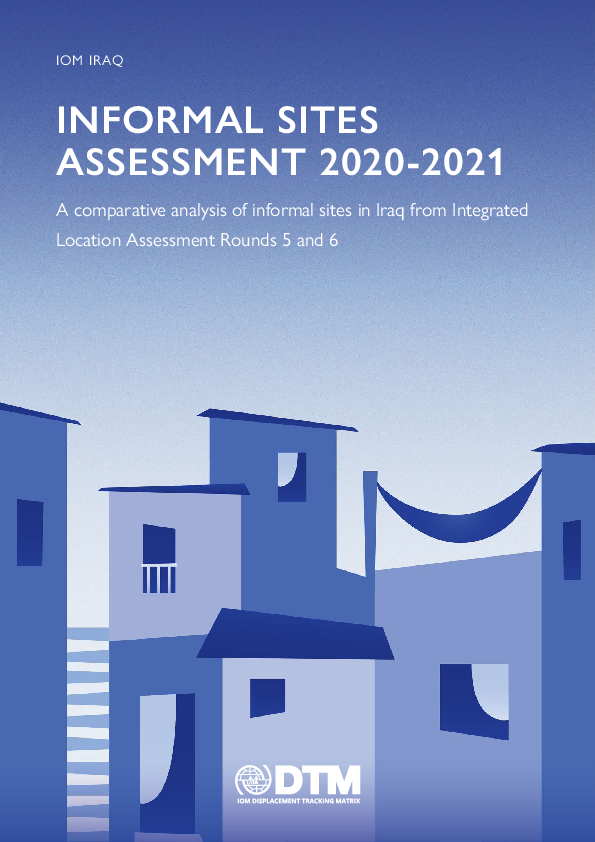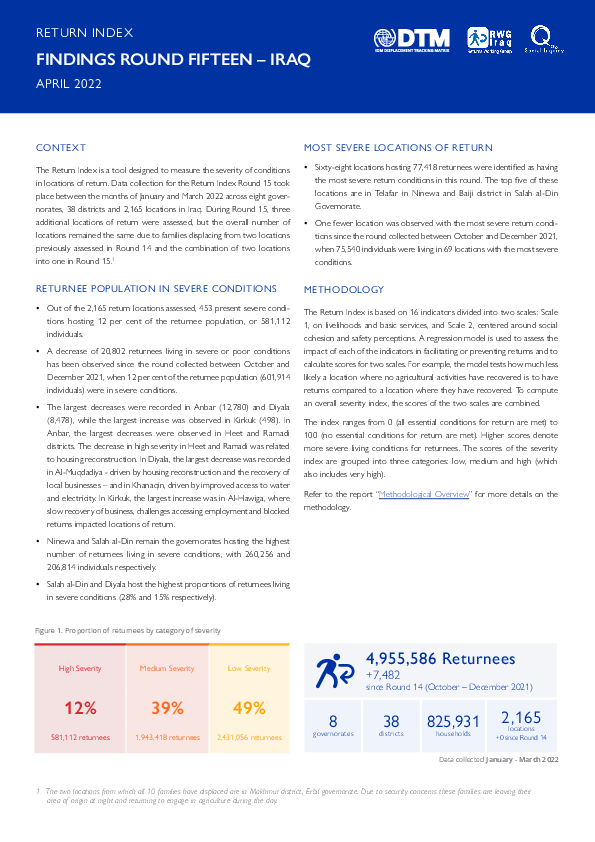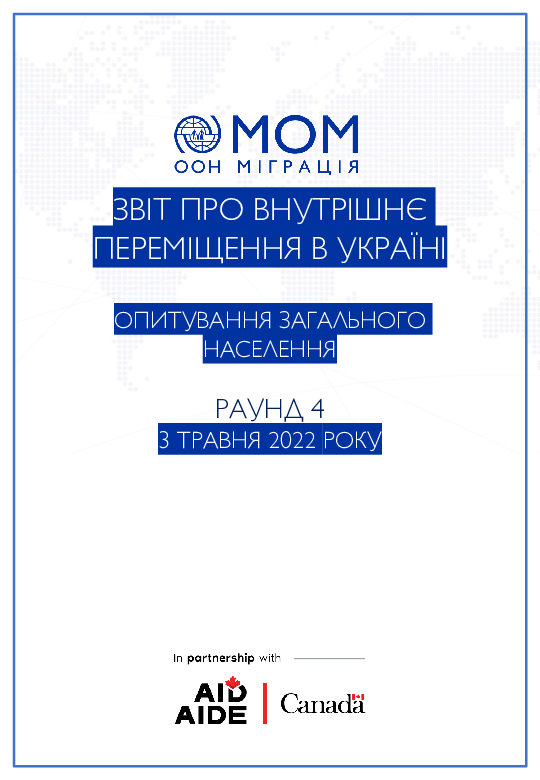-
Countries
-
Data and Analysis
-
Special Focus
-
Crisis Responses
Contact
DTM Libya, DTMLibya@iom.int
Language
English
Location
Libya
Snapshot Date
Apr 30 2022
Activity
- Mobility Tracking
- Site Assessment
Detention Centre Profiling is a component of IOM Libya’s Displacement Matrix programme. It is a data oriented tool that routinely provides specific sex and age demographic data and key sectorial information on individuals held in Libya’s detention centres on the date of assessment.
Contact
DTM Cameroon, DTMCameroon@iom.int
Location
Cameroon
Activity
- Mobility Tracking
- Baseline Assessment
Period Covered
Feb 09 2022 -Feb 16 2022
A baseline assessment is a sub-component of mobility tracking. It aims to collect data on IDP, migrant or returnee population presence in a defined administrative area of the country.
Population Groups
Survey Methodology
Unit of Analysis Or Observation
Type of Survey or Assessment
Keywords
Geographical Scope
Administrative boundaries with available data
The current dataset covers the following administrative boundaries

Contact
iombeirut@iom.int
Language
English
Location
Lebanon
Period Covered
Oct 19 2021
Dec 03 2021
Activity
- Other
- Survey
- Migrants presence
Socioeconomic conditions in Lebanon have deteriorated dramatically, creating severe economic hardship across the country. State bankruptcy since 2019 has led to crippling inflation, widespread unemployment, and currency collapse, which together have triggered a sharp rise in the cost of living, and left thousands of households unable to meet their basic needs. The country’s economic collapse was exacerbated by COVID-19 and the suspension of work that followed, disrupting thousands of livelihoods, particularly for those earning daily wages. In Beirut, the devastating Port Explosions in August 2020 were another severe blow to peoples’ welfare, destroying houses, healthcare facilities, and businesses.
This MSNA 2021 exercise collected data on access to services, needs and vulnerabilities among Lebanese nationals, Palestine Refugees in Lebanon (PRL) and migrants. This report aims to complement findings from the 2020 MSNA in Beirut by providing an insight into how countrywide, migrants’ needs and vulnerabilities have evolved amid continuing economic decline. It presents data specifically related to migrants, including demographic profiles and in-depth multi-sector analysis of the challenges migrants face in accessing healthcare, livelihood opportunities and protection services. Findings also provide data on additional needs and vulnerabilities related to shelter, food security, and WASH. Overall, the report aims to reinforce baseline knowledge regarding migrant needs in Lebanon.

Contact
DTM Iraq, IraqDTM@iom.int
Language
English
Location
Iraq
Period Covered
May 01 2021
Jul 31 2021
Activity
- Survey
- Return Intention
- Mobility Tracking
- Baseline Assessment
As of July 2021, ILA 6 recorded a total of 418 informal sites. IDP families were present in 389 informal sites and returnee families were present in 31 sites. Dahuk Governorate contains 38 per cent of the informal sites nationwide (160), with Ninewa and Salah al-Din accounting for a further 18 per cent and 12 per cent, respectively (76 and 52 sites). Overall, 13,533 families were recorded as residing in informal sites in ILA6 (12,490 IDP families and 1,043 returnee families). The largest share of this population is in Anbar Governorate (28%), followed by Dahuk (24%) and Salah al-Din (14%). Between ILA 5 and ILA 6, the number of families residing in informal sites decreased by four per cent, from 14,067 to 13,533. In the same period, the number of informal sites decreased by 15 per cent , from 490 to 418 sites. The number of informal sites fell significantly in Dahuk Governorate, where there were 41 fewer sites in recorded in ILA 6. This decline is attributed to returns, predominantly to Sinjar district in Ninewa Governorate, as well as families entering camps to receive assistance, and families moving to non-critical shelters which, in a limited number of cases, was their rehabilitated residence of origin. Other governorates where the number of informal sites declined included Salah al-Din which recorded 25 fewer sites, and Kirkuk Governorate, with 19 fewer sites. Baghdad Governorate, however, recorded 11 new informal sites in ILA 6, with eight of these located in the district of Mahmoudiya.

Contact
DTM Iraq, IraqDTM@iom.int
Language
English
Location
Iraq
Period Covered
May 01 2021
Jul 31 2021
Activity
- Survey
- Return Intention
- Mobility Tracking
- Baseline Assessment
Since January 2014, Iraq’s war against the Islamic State of Iraq and the Levant (ISIL) has caused the displacement of over 6 million Iraqis – around 15 per cent of the entire population of the country. Displaced communities began to return in waves from March 2015, following the military campaigns to retake areas under ISIL control and driven by expectations of restored stability, which peaked between June 2017 and June 2018 when nearly 4 million individuals returned to their location of origin, and since then the rate of return has slowed considerably. As of July 2021, around 4.9 million returns have been recorded across 2,162 locations in Iraq, but 287 locations nationwide have not yet witnessed returns. Around 1.2 million individuals remain in displacement, including those enduring secondary displacement and/or failed returns, mostly because of ongoing safety and
security issues at the area of origin.
The Integrated Location Assessment (ILA) is an annual assessment that collects detailed information through key informants on displaced and returnee households living in locations identified through the Displacement Tracking Matrix (DTM) Master Lists. The reference unit of the assessment is the location, which is defined as an area that corresponds with either a village for rural areas or a neighbourhood for urban areas (i.e. fourth official administrative division). Routinely collected information includes geographic distribution and main characteristics of internally displaced persons (IDPs) and returnees, mobility and future intentions including obstacles to return and/or reasons to stay/return, living conditions and main needs, state of infrastructure and
services, security incidents, feelings of safety, social cohesion and reconciliation issues, and specific protection and risk indicators. The ILA VI was conducted in May–July 2021 and covered 3,757 locations, reaching 4,876,170 returnee individuals
and 1,154,462 IDP individuals (representing 99% of all recorded returnees and 97% of IDPs).

Contact
DTM Iraq, IraqDTM@iom.int
Language
English
Location
Iraq
Period Covered
May 01 2021
Jul 31 2021
Activity
- Mobility Tracking
- Baseline Assessment
Since January 2014, Iraq’s war against the Islamic State of Iraq and the Levant (ISIL) has caused the displacement of over 6 million Iraqis – around 15 per cent of the entire population of the country. Displaced communities began to return in waves from March 2015, following the military campaigns to retake areas under ISIL control. Returns were driven by expectations of restored stability and peaked between June 2017 and June 2018 when nearly 4 million individuals returned to their location of origin, since then the rate of return has slowed considerably. As of July 2021, around 4.9 million returns have been recorded across 2,162 locations in Iraq, but 287 locations nationwide have not yet witnessed returns. Around 1.2 million individuals remain in displacement, including those enduring secondary displacement and/or failed returns, mostly because of ongoing safety and
security issues at the area of origin.
The Integrated Location Assessment (ILA) is an annual assessment that collects detailed information through key informants on displaced and returnee households living in locations identified through the Displacement Tracking Matrix (DTM) Master Lists. The reference unit of the assessment is the location, which is defined as an area that corresponds with either a village for rural areas or a neighbourhood for urban areas (i.e. fourth official administrative division). Routinely collected information includes geographic distribution and main characteristics of internally displaced persons (IDPs) and returnees, mobility and future intentions including obstacles to return and/or reasons to stay/return, living conditions and main needs, state of infrastructure and
services, security incidents, feelings of safety, social cohesion and reconciliation issues, and specific protection and risk
indicators. The ILA VI was conducted in May–July 2021 and covered 3,757 locations, reaching 4,876,170 returnee individuals
and 1,154,462 IDP individuals (representing 99% of all recorded returnees and 97% of IDPs).

Contact
DTM Iraq, IraqDTM@iom.int
Language
English
Location
Iraq
Period Covered
Jan 01 2022
Mar 31 2022
Activity
- Survey
- Return Intention
- Mobility Tracking
- Baseline Assessment
The Return Index is a tool designed to measure the severity of conditions in locations of return. Data collection for the Return Index Round 15 took place between the months of January and March 2022 across eight governorates, 38 districts and 2,165 locations in Iraq. During Round 15, three additional locations of return were assessed, but the overall number of locations remained the same due to families displacing from two locations previously assessed in Round 14 and the combination of two locations into one in Round 15.

Contact
DTM Iraq, IraqDTM@iom.int
Language
English
Location
Iraq
Period Covered
Jan 01 2022
Mar 31 2022
Activity
- Mobility Tracking
- Baseline Assessment
Data collection for Round 125 took place between 1 January and 31 March 2022. As of 31 March 2022, DTM identified 4,959,714 returnees (826,619 households), dispersed across 8 governorates, 38 districts, and 2,179 locations in Iraq. A total of 7,482 new returnees were recorded between January and March 2022. This is significantly lower than the number of returns recorded in
the previous period between October and December 2021 (13,158). Notably, this is the lowest number of returns recorded since they commenced in April 2015. During this period, the highest number of newly arrived returnees was recorded in Salah al-Din (3,174), followed by Ninewa (2,064), Anbar (660), and Baghdad (612).
Additionally, between January and March 2022, DTM identified a total of 1,184,818 IDPs (203,447 households), dispersed across 18 governorates, 105 districts, and 2,803 locations. This represents an overall net decrease of 1,738 IDP individuals since the October-December 2021 period, and is a smaller decrease than what was recorded between then and August-September 2021 (3,025). Regarding IDPs’ area of origin, consistent with the previous round, 56 per cent of the current caseload of IDPs come from Ninewa governorate (663,138), especially from the districts of Mosul (246,229), Sinjar (193,354), and Al-Ba’aj (93,751). The next highest shares of IDPs come from the governorates of Salah al-Din (137,726; 12% of the total caseload), Anbar (133,321; 11%), Kirkuk (75,873; 6%), and Diyala (73,946; 6%).

Contact
DTM Nigeria, AllUsersInDTMNigeria@iom.int
Language
English
Location
Nigeria
Period Covered
Apr 01 2022
Apr 30 2022
Activity
- Mobility Tracking
- Baseline Assessment
- Points of Entry (PoE)
During the COVID-19 pandemic, IOM's Displacement Tracking Matrix (DTM), in collaboration with the World Health Organization (WHO), monitors cross-border movements to and from Nigeria's Borno State in north-east Nigeria. Assessments are conducted at Points of Entry located along the border with Cameroon.
A range of data was collected during the assessments to better inform on travellers’ nationalities, sex, reasons for moving, mode of transportation and timeline of movement as shown in figures 2 to 5 below.

Contact
DTMUkraine@iom.int
Language
Ukrainian
Location
Ukraine
Period Covered
Apr 29 2022
May 03 2022
Activity
- Survey
Війна в Україні, яка розпочалася 24 лютого 2022 року, спричинила безпрецедентну гуманітарну кризу, що охопила всі області країни. У період з 29 квітня по 3 травня Міжнародна організація з міграції (МОМ) провела четвертий раунд репрезентативного експрес-оцінювання загального населення України для збору інформації стосовно потоків внутрішнього переміщення та мобільності, а також для оцінювання місцевих потреб. Це оцінювання загального населення слугує первинним джерелом для виявлення сфер із високими гуманітарними потребами та визначення цільових заходів реагування для надання допомоги населенню, що постраждало від війни. Географічне охоплення цього оцінювання покриває всю територію України, усі п’ять макрорегіонів (захід, схід, північ, центр, південь та місто Київ), за винятком Кримського півострова.
Опитування загального населення було проведено шляхом набору випадкових телефонних номерів, завдяки чому було анонімно опитано 2 000 унікальних респондентів віком від 18 років із використанням методу автоматизованого телефонного опитування (CATI). Оцінка спирається на дані про населення Фонду народонаселення ООН (UNFPA), які гуманітарна спільнота розглядає як базове значення для чисельності населення в Україні. Особи, які нині перебувають за межами України, під опитування не потрапили. Докладніше про метод і обмеження, у тому числі про визначення МОМ терміна «внутрішньо переміщені особи» для цілей цього оцінювання, див. на с. 11.
Цей звіт також доступний англійською мовою.